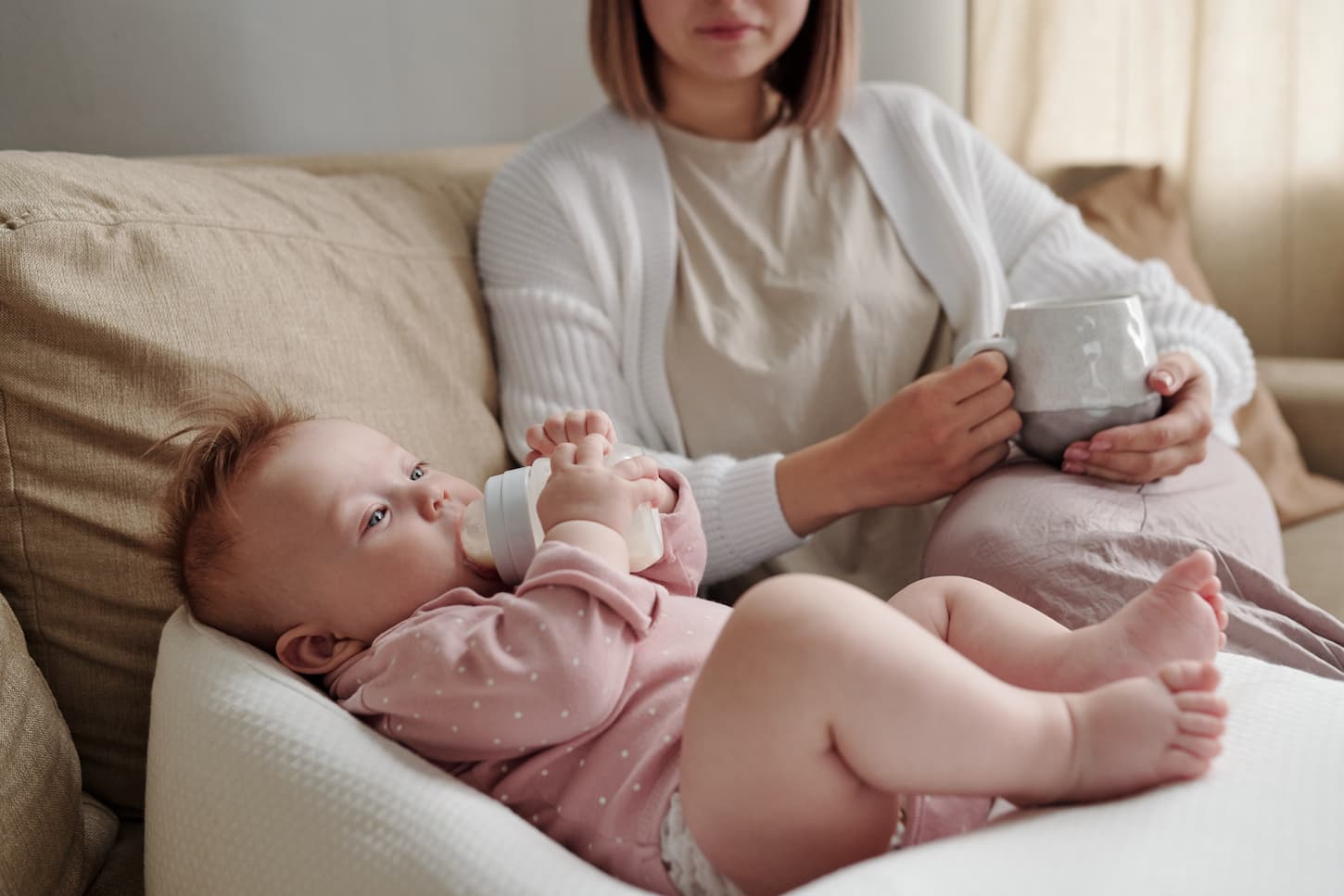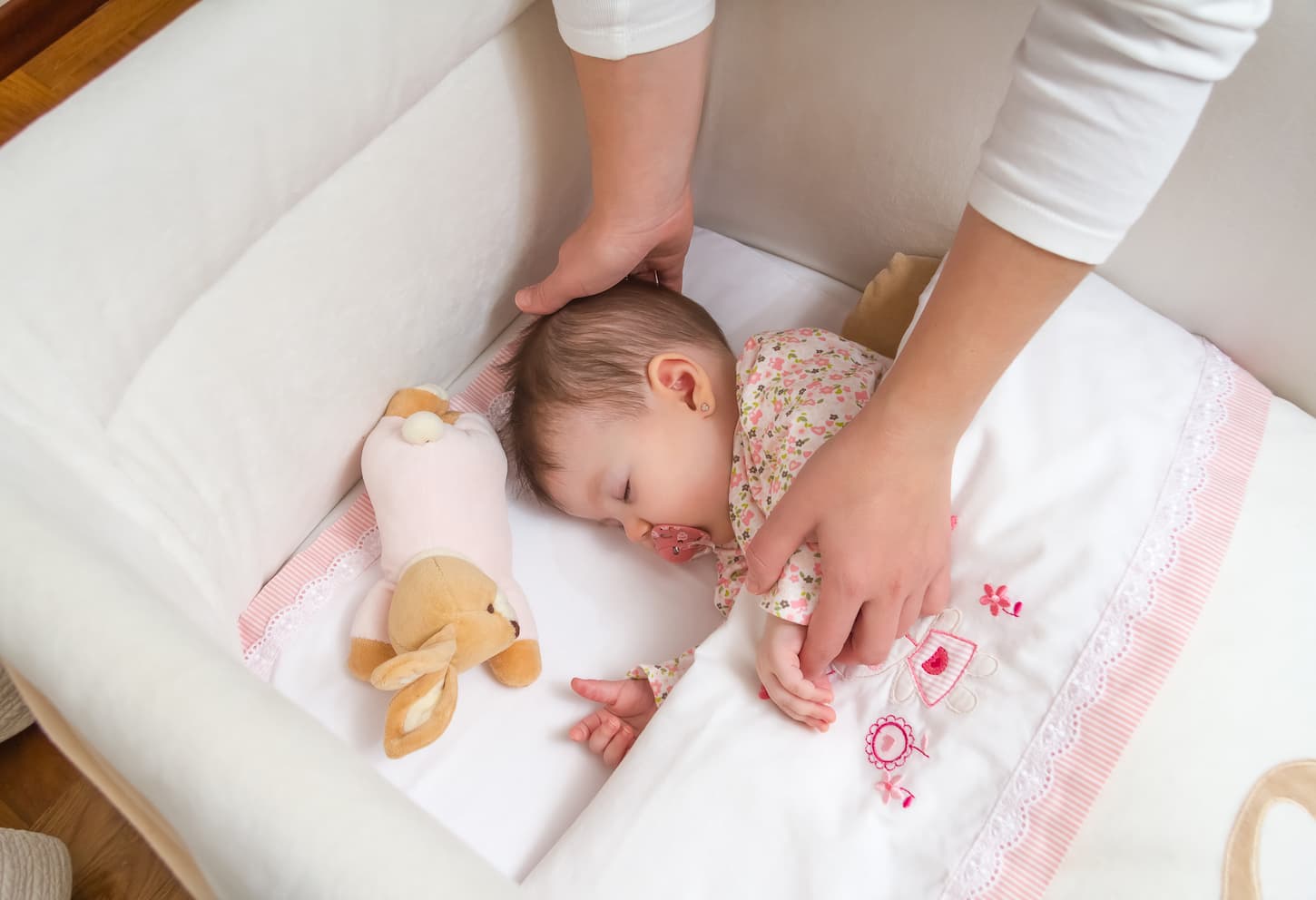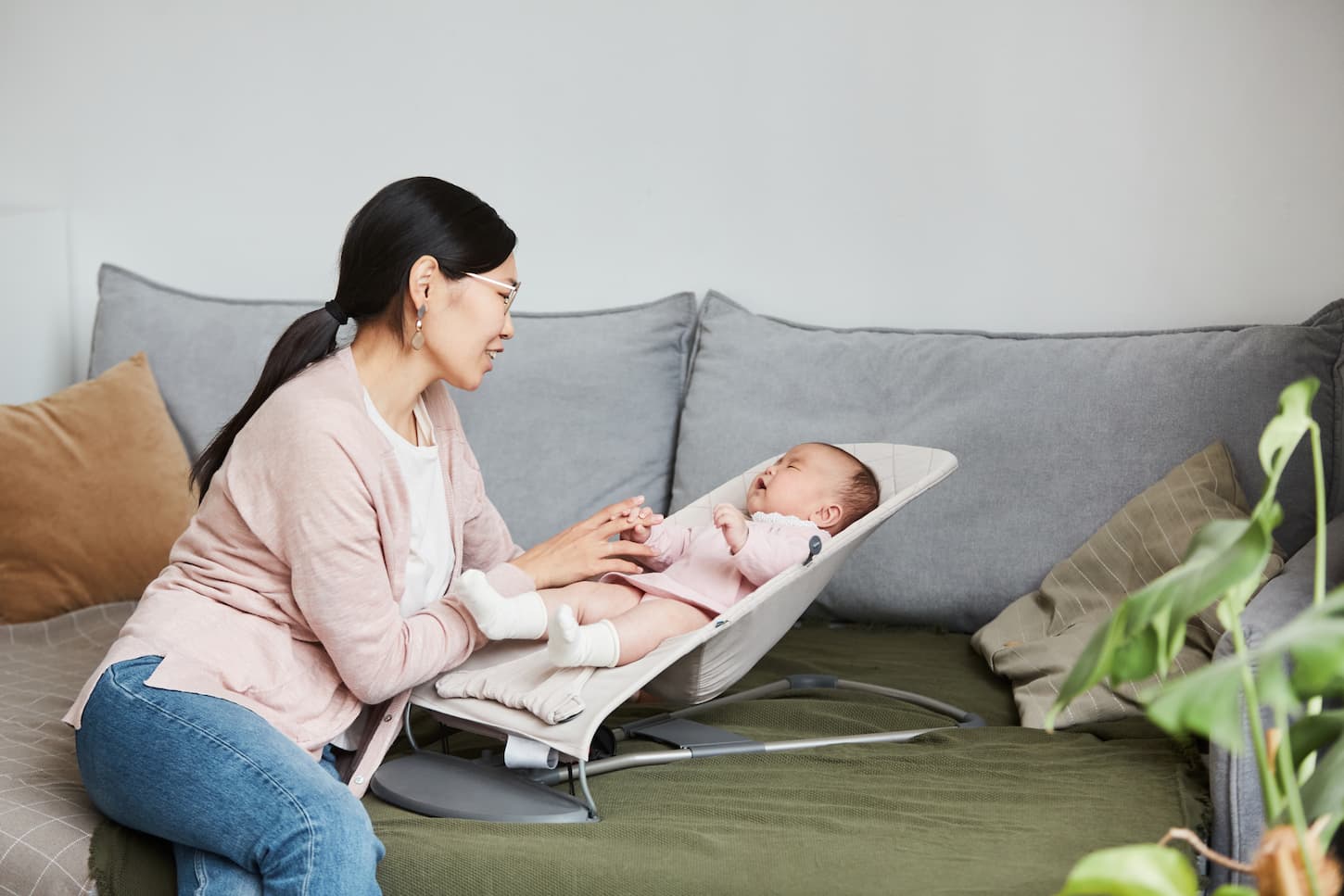As I’ve continued to study and research sleep training extensively, I’m frequently asked, “What sleep training method works best?” The short answer is that it depends. The better solution is a multifaceted thing – so let’s talk about what sleep training works.
Finding the best sleep training method for your family may require trying out several methods, as there is no “best” or cure-all method. What sleep training works best (or worst) will depend on your parenting style, your baby, and how it’s implemented.
Even so, here are 20 things you need to know when trying to determine which sleep training method will work best for your family.

Which Sleep Training Method is Right for Your Baby?
There’s a reason there are so many sleep training methods to choose from: every parent, child, and family has a different personality and dynamic!
Now, the answer won’t always be the same except for this: the sleep training method that works best is whichever one works for you.
In other words, the sleep training that will work best for you will depend on:
- Your parenting style.
- Your child’s temperament, behavior, and needs.
- Your family’s specific dynamics.
- Your goals.
- And more.
Even if you pick a specific sleep training method that you think will mesh well with all of the above, it may not end up working. In those cases, you may have to try other methods – and the one that works may surprise you.
So if you have to try multiple sleep training methods, you aren’t doing things wrong – you’re using the process of elimination to rule out the methods that don’t work. That way, you can find what will work.
When You Can Start Sleep Training
Most babies can be successfully sleep trained once they’re at least 4-6 months of age. Now, that doesn’t mean you have to sleep train once your baby is 4, 5, or even 6 months old.
What it means is that, once your baby is old enough you can sleep train them – if they need it. Many babies won’t need it. How do you know if you need sleep training?
Ask yourself this question: is the current sleep schedule and/or situation an issue? If it is (and your baby is old enough) then it’s time to sleep train.
However, if the current situation is sustainable and fine by you, you don’t need to do anything except keep going. You may choose to be more focused on healthy sleep practices – and that may help prevent the need to sleep train in the future.
To read more about the general sleep training guidelines, including why there’s a minimum age for sleep training, read my article on sleep training guidelines right here.
How to Know if You Should Let a Baby Cry it Out
In some cases, cry it out (extinction) may be the only viable sleep training solution. Here are some times when you should consider letting a baby cry things out:
- Other sleep training methods haven’t worked. Age-appropriate, behavior-based sleep training methods haven’t helped the baby sleep better despite adequate attempts and time.
- Other methods haven’t worked for you. As a parent, you are unable to fully implement behavior-based sleep training successfully.
- There’s a deadline or severe sleep deprivation that requires an immediate change. Due to circumstances or severe sleep deprivation, immediate results are absolutely required and recommended by a physician.
Not every child will have a positive experience with behavior-based sleep training. Not every parent is going to implement or use behavior-based sleep training successfully. That’s not wrong or abnormal – it’s the law of averages.
And while there are some studies that say that cry it out does increase immediate cortisol levels (and therefore stress), it can still be safely done as long as you account for all aspects of your child’s health, wellbeing, and development. For more information on those aspects of safety, please refer to my article on sleep training safety.
In other words, if your baby is old enough and nothing else has worked or you’re on a deadline, cry it out may become your best bet. Just know it’s not a popular method – except among those parents who have also had to use it.
How Do You Sleep Train Without Crying it Out?
It is definitely possible to sleep train without having your baby cry. The trade-off for not crying, however, is that it can take longer and it requires a lot more patience and work on your part.
The best ways to sleep train without tears are by using behavior-based sleep training methods. Personally, fading has been my favorite method, because it allows you to go from where you are (the current normal) to the new normal gradually.
That way, sleep training is just a transitional process rather than an event.
For more information on behavior-based sleep training, see my complete guide here.
How Long Does Sleep Training Take?
Sleep training can take anywhere from a few nights up to several months, depending on all of the involved factors. In most cases, though, it only takes about two weeks.
I’m working on additional articles on this exact topic – so stay tuned to the homepage and the latest articles for more details.
Formal Sleep Training Isn’t For Everyone
Sleep training isn’t for everyone, and that’s okay. There are actually several reasons for this:
- Some parents are more naturally in-tune with sleep and so their children don’t need formal sleep training.
- Sleep training is too contrived for some parents, so they don’t use it.
- Some parents see sleep training as a last resort.
- Other families focus on sleep hygiene (quality sleep) that naturally progresses children into healthy sleep habits without training.
After extensive research and digging through studies, doctors have widely ranging estimates on how many families will need formal sleep training. Some say it’s as low as about 30% of families, while others say it’s in excess of 80%.
In any case, if you choose not to formally sleep train, that’s okay. If you focus on teaching your children healthy sleep habits and hygiene, that’s enough. It will naturally teach your children to sleep without any formal training required.
For more details on when you should quit sleep training, see this article.

Choose a Sleep Training Method That Jives with Your Parenting Style
If you want to successfully sleep train your baby, you need to pick a method that will work with your parenting style. That way, it will actually have a chance at working!
Here are the most common sleep training methods, with a brief description of each.
| Sleep Training | Definition Or Methodology | Also Known As |
|---|---|---|
| Graduated Extinction | Parents gradually delay their response to an infant’s cry. | Controlled Crying |
| Bedtime Fading | A parent gradually delays an infant’s bedtime over time. | |
| Controlled Comforting | Parents physically comfort a crying child, though the length and type of comfort gradually diminish. | Pick Up, Put Down |
| Adult Fading | A parent gradually stays less and less time with a child after putting them down for bed. | Camping Out |
| Camping Out | A parent “camps out” in the room after bedtime. Each night, the parent moves their chair one step further from the crib until the child graduates from needing a parent present to fall asleep. | The Chair Method |
| Pick Up, Put Down | Every time a child cries, the parent picks them up and comforts them until calm. Once calm, the baby is placed back in the crib. | Controlled Comforting |
| Pure Extinction | After a loving and active day, put your baby down to bed using the regular bedtime routine. Let them cry themselves to sleep. Checking on them is up to the parent’s decision, both after bedtime and during the night. | Cry it Out |
No matter what judgy people say, pick the method that works for you and your parenting style. You can pick any method on here – and someone will vocally judge you for it. So don’t let that fear of judgment be your guiding principle. You aren’t picking a sleep training method to make the neighbors happy.
You’re picking a sleep training method that will make you and your baby happy – while also helping everyone get enough sleep.
Test Your Sleep Training Method
Once you’ve selected your sleep training method, you have to test and try it out. Now, it’s also got to be a dedicated test that you’re committed to, or it will be doomed to fail.
But once you’re committed to it and have everything planned out, give it a solid try. And by solid, I mean to try it for at least a couple of weeks. Most successful sleep training methods take at least a couple of weeks to see success. So be committed to trying and testing the method out for at least that long.
Now, there may be extreme cases where sticking to a specific method is a problem. If that’s the case, please don’t keep trying! Go ahead and quit – and try something else. Pick a different method – and test that instead.
See How Your Child Reacts to Sleep Training
As you implement and test the sleep training method of your choice, be sure to track reactions and results. Specifically, see how your child is reacting to sleep training.
Here are some things to watch for:
- Watch how your baby wakes up in the morning – are they happier and better rested?
- How does your baby react to bedtimes and naptimes after several days or weeks?
- Is your baby happier during the daytime?
- How many nighttime wakings and feedings are there? Are they going easier?
- Is your baby smiling more and playing more?
You see, as you sleep train, you’ll know that things are working because everyone is getting more sleep – and everyone is naturally happier (because they’ve gotten enough sleep!).
So watch for those smiles – they’ll make the hard nights and sleep training sessions much more bearable.
What Works is What Gets Results
Now, most sleep consultants and experts will probably try and tell you that there is always one method that is the right one – and there is always a wrong way to do things.
However, let’s look at things from the law of averages, based on the fact that every child, parent, and family is different. As such, things will work differently for everyone.
There’s no inherently right or wrong sleep training method – there’s what works and what doesn’t.
Now, that does come with the huge caveat that there is still a way to make any sleep training method safe – and also a way to take things to an unsafe extreme. But as long as you are actively trying to make sleep training a safe, positive experience, there’s not a right or wrong way to do things.
There’s just what works and gets results – and everything else.
Just keep in mind that what works for you and one child may not work for your other children – and it may definitely not work for other families.
“Best” and “Worst” Sleep Training is a Myth
Because there’s no one right way to do things (and no one wrong way to do things), the idea of a “best” and “worst” sleep training method is a myth. Sure, there are sleep training consultants and coaches who propagate that myth. After all, tapping into those fears does get them more business.
Instead, here’s what works – and what doesn’t.
Again, the huge warning that any method can be taken to an unhealthy extreme. Be sure to keep things safe – you can refer to my article about sleep training safety for specifics.
But if you’re doing things safely, there’s not a wrong or a right way to sleep train. There’s just what gets you there – and everything else that didn’t happen to work for you this time.

You May Need to Try Several Sleep Training Methods Before it Works
Again, there are multiple paths to the destination of sleep training (and a full night’s sleep). As such, you may need to try several different paths – and see which one is easiest for your family.
That way, you can focus on reaching the destination – instead of being stuck on one path that’s difficult and wondering why it’s not working.
Quit getting stuck on one path. If one sleep training method doesn’t work, try another method. It’s not quitting – it’s being strategically minded and focused on the results. Don’t be so overwhelmed by the journey that you forget about the destination.
Many families end up trying several sleep training methods before finding the one that actually works for them. That’s okay and totally normal. Go ahead and test things.
Each Child May Need a Different Sleep Training Method
Because each child is unique, what works for one may not work for the next. This is true of parenting styles, discipline, and sleep training.
So if one child needs a different sleep training method, that isn’t a reflection on your skills or abilities. Instead, it means that your child needs you to help them differently than did your other child. That’s okay. Go ahead and help them how they need it – and things will be much easier.
For us, there were aspects of sleep training that had a good bit of overlap. And then there were areas (mostly naps!) of sleep training where each of our four children had hugely different needs. Trying to treat them, all the same, did not work. It was when we individualized their sleep training plans that we finally saw success.
Again, there’s no one right answer for sleep training. There’s what works – and what doesn’t. So go ahead and individualize things for your child. And then individualize again for their siblings. It’ll make things so much easier!
The Key Qualities of Making Sleep Training Work
When it comes to sleep training, it’s going to take a lot of hard work. Here are the key qualities you’ll need to survive sleep training – and make it work.
- flexibility
- consistency
- right timing, right place
- luck
- understanding of development
- understanding of sleep training, sleep training methodology, and best practices (via evidence-based research)
- patience
Now, if those qualities don’t come naturally to you, that’s okay. Sleep training will be a great time to practice them. These are qualities that you will continue to develop throughout your life as a parent – and just in life in general.
Even so, the understanding of development, sleep training, sleep training methodology, and current best practices via evidence-based research isn’t something that’s as easily accessible. That’s okay – that’s why I created this website – to give you easy access to all of the latest information.
In other words, the fact that you’re here and reading about sleep training means you’re actively working on developing these qualities – and getting the knowledge you need to see positive sleep results.
Sleep Training Guidelines to Know
As you’re considering what sleep training works, it’s important to remember the five basic guidelines.
- Know when it’s appropriate and safe to sleep train.
- Choose a sleep training method that will work for you, your child, and your parenting style.
- Use that method to create a personalized sleep training plan.
- Change your plan as needed.
- Be patient and consistent – while remembering that sleep training may take as long as a month or more.
Remembering these guidelines will help make sure that your sleep training method will work – no matter which it is you originally picked.
Read more: sleep training guidelines (everything you’ve ever asked!).
Remember to Rock that Bedtime Routine
As you’re working to make sleep training a positive experience that works, one of the keys is using a bedtime routine.
Now, there are an awful lot of less-than-helpful posts and articles about all of the things that “have” to be in a bedtime routine. However, a bedtime routine can be as simple and basic or long and complicated as you want it to be.
That being said, a warning: just because you want to include certain activities at bedtime doesn’t mean you should.
For our children, we’ve found that baths, songs, and stories don’t always work well at bedtime. They may work on occasion but are no longer part of our regular bedtime routine because they don’t help our children sleep better.
Just like with sleep training, your bedtime routine is going to become a highly personalized thing. That’s normal – that’s how it should be. You’re going to need to find what works at bedtime and what doesn’t.
It’s going to need some trial and error to find those sleep-enhancing events that should be part of the bedtime routine while ruling out those activities that excite your children (and should therefore NOT be part of the bedtime routine!).
Give yourself time to find the right bedtime routine. And remember that the bedtime routine will evolve over time as your children age, have more siblings, and needs change.
Don’t Forget a Positive Sleep Environment
In order to set the stage so that sleep training works, it’s vital that you build a positive sleep environment for your children.
Now, while there will be some variation in what works for a positive sleep environment, here are some general guidelines that really help.
- Keep bedrooms for sleeping.
- Sleeping is easier in a cool, dark, comfortable environment.
- Keep screens and devices out of bedrooms.
- Blackout curtains and a white noise machine may prove invaluable.
Our kids sleep best in a dark, cool room where there’s white noise to drown out the sounds of the day (so FOMO – fear of missing out – doesn’t keep them up). We keep toys, screens, and anything deemed too exciting (or problematic to sleeping) outside of their bedroom.
To see the bedroom gear I use and recommend, click here.

What Works for You Won’t Work for Everyone Else
We’ve talked briefly throughout this whole article about how being judged for sleep training (or being judged for not sleep training) is a real thing. There’s not much you can do about it – the McJudgersons will judge no matter what you do.
Even so, don’t become one of the McJudgersons. Here are some key points to remember about judging.
- What works for you won’t work for everyone else.
- Be nice to others.
- Don’t try to force your favorite sleep training method on others.
Sleep training is a highly personal, family-based decision. What works for you won’t work for others. That’s fine. Do what works for you.
Expect to Hear Opinions on Sleep Training
Sleep training (and parenting techniques) are a polarizing subject. While parents generally all have the same goal (to raise well-adjusted and independent children), there are so many paths to get to the goal.
And there are some very vocal individuals on which path is best. So expect to hear all sorts of opinions and advice on sleep training – even if you didn’t ask for any.
- You may not be able to stop someone from running their mouth, but you don’t have to do what was suggested.
- When someone offers unsolicited advice, don’t be offended. Offer a simple answer. Something like, “Oh, that’s an interesting thought. Thank you for sharing your opinion.”
- Don’t repeat the cycle. Don’t offer unsolicited advice. Ask if you can offer advice – and then see if the offer is accepted before continuing.
Most people do genuinely think they’re helping you to make sure that you see success with sleep training. Reminding myself of that fact makes it easier for me to accept that unsolicited advice – and to be kind in return.
Remember, though: you don’t have to accept unsolicited advice or opinions – even mine!
Remember You are Your Child’s Best Advocate
You are the expert on your child. As such, you are their best advocate. It’s up to you to help guide them as they grow and develop. So do your best. See what works – and use what doesn’t work to help you find something better.
Parenting and sleep training is not easy, but they are doable. So find what works for you, your children, and your family. Then, go with it.
You’ve got this – and we’re here to support you through the whole sleep training journey.